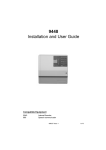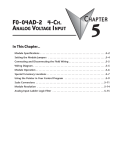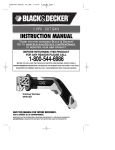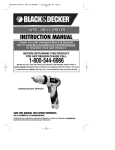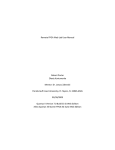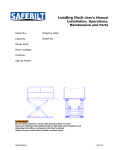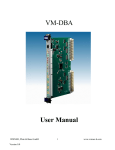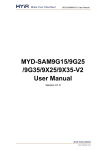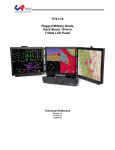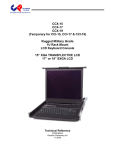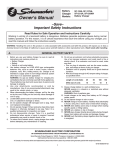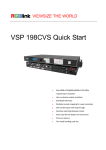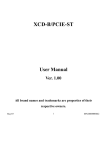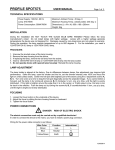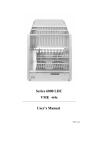Download W-Ie–Ne-R VPX3C Power Supply - W-IE-NE
Transcript
W-Ie–Ne-R VPX3C Power Supply 3U 4HP 28 VDC Conduction Cooled 715 W VPXTM Power Supply User’s Manual V2.1 W-IE-NE-R Plein & Baus GmbH Rev. 2.1, March 13, 2015 1 www.wiener-d.com General Remarks The only purpose of this manual is a description of the product. It must not be interpreted as a declaration of conformity for this product including the product and software. W-Ie-Ne-R revises this product and manual without notice. Differences between the description in manual and the product are possible. W-Ie-Ne-R excludes completely any liability for loss of profits, loss of business, loss of use or data, interrupt of business, or for indirect, special incidental, or consequential damages of any kind, even if W-Ie-Ne-R has been advises of the possibility of such damages arising from any defect or error in this manual or product. Any use of the product which may influence health of human beings requires the express written permission of W-Ie-Ne-R. Products mentioned in this manual are mentioned for identification purposes only. Product names appearing in this manual may or may not be registered trademarks or copyrights of their respective companies. No part of this product, including the product and the software may be reproduced, transmitted, transcribed, stored in a retrieval system, or translated into any language in any form by any means without the express written permission of W-Ie-Ne-R. W-IE-NE-R Plein & Baus GmbH 2 www.wiener-d.com Table of contents: 1 GENERAL DESCRIPTION .................................................................. 4 2 MAIN FEATURES.................................................................................. 5 3 FUNCTIONAL DESCRIPTION ........................................................... 5 4 TECHNICAL SPECIFICATION.......................................................... 9 5 SWITCH-ON BEHAVIOR .................................................................. 10 6 DERATING CURVES .......................................................................... 11 W-IE-NE-R Plein & Baus GmbH 3 www.wiener-d.com 1 General Description The W-Ie-Ne-R VPX3C is a high power density power supply in a 3U height 4HP width VPX form factor designed according to VITA 62.0 VPX conduction cooled standard and largely to VITA 46.0 VPX. It provides with 715W more than sufficient power to all main and auxiliary power rails deliverable by VPX at high efficiency and of low ripple and noise. Efficiencies up to 93% are reached by using newest zero voltage switching (ZVS) technologies for the conduction cooled converters. Hence lower power losses can be more effectively distributed through the highly heat conductive aluminum case to the wedge locks to the outer ATR case. An integrated load sharing device allows for paralleling of two or more power supplies on customized VPX backplanes when even more power is needed. Our Phoenix Mecano partner HARTMANN Electronic offers a wide range of air and conduction cooled U3 ATR chassis and backplanes for laboratory, test and also professional use for airborne equipment. Please refer to http://www.hartmann-elektronik.de/ for more information. Additional input filters like the DSF500 from XPPOWER™ will allow to upgrade input protection to military levels MIL-STD 1275A-D, MIL-STD-461F, DEF-STAN 61-5 Pt 6. W-IE-NE-R Plein & Baus GmbH 4 www.wiener-d.com 2 Main Features • 715W continuous wattage, low noise power supply acc. to VITA 62/46 VPX specification • 3U (half height) 4HP (slim size, 0.8” pitch) conduction cooled VPX form factor • Zero Voltage Switching Converter Design with up to 93% efficiency @ 28V DC input • VS1: 21A @ 12 V, VS2: 50A @ 3V3, VS3: 40A @ 5V • AUX1: 7A @ 3V3 aux, AUX2: 4.2A @ +12Vaux, AUX3: 4.2A @ -12Vaux • Industrial storage and operating temperatures • Fully overall and individual power rail protections: o Over Temperature OVT o Over Voltage OFLW o Under Voltage UFLW o Over Current OC • No input current protection, input overvoltage protection, input surge protection, reverse polarity protection – individual external protections needed acc. to the diverse applications 3 Functional Description All voltage ZVS converters are isolated (1500V isolation voltage) and fed via a common Filter Network from the same 28V main supply (20V – 35V). 3V3aux is not independent but protected by a resettable fuse (PTC). All individual output voltages (6x) are sensed by window comparators for over- and under voltages which are monitored from a central control logic device (CPLD). Any failure on the output voltages are signaled on the front panel by corresponding FAIL LEDs and lead to a switch off of all voltages (by default). If all internals are normal the blue READY LED is working. Figure 1 shows gives an overview over the front panel elements. W-IE-NE-R Plein & Baus GmbH 5 www.wiener-d.com Figure 1: Front panel functional elements of the VPX3C Power Supply Control Logic: Depending on the main bus signals also the green RUN LED goes on and the power supply tries to start working. According to VITA 62 and VITA 46 the logic run line condition is – when “#” is nomenclature for the negative logic main bus signals, logic negation is signaled by the “¬” sign, and a positive logic transition by “↑”: RUN = ( ¬ #ENABLE AND #INHIBIT AND #FAIL AND ¬INTERNAL_FAIL ) “REFRESHED AFTER FAIL WHEN” ↑ ( ¬ #SYSRESET OR ¬ #RESET_BUTTON OR POWER_ON ) This means that the if the global inhibit is not set (= released to H), whether no internal or external failure occurs (both are released to H) the power supply starts. After some kind of failure (internal or external) the power supply restarts by one of the following three conditions: A power cycle, a push onto the front panel button or a remote reset via the main bus system reset (#SYSRESET). By default all voltages go down promptly if one of the run line conditions is not met. When an internal failure occurs the delay or failure hold time to a complete switch off of the power supply is a half second to a second. This logic prevents any hardware from defects caused by unsymmetrical power faults (analogue operational circuits) or partial power faults (CPUs). W-IE-NE-R Plein & Baus GmbH 6 www.wiener-d.com Failure LEDs: To know exactly the reason of the last failure two fail LEDs on the front panel for every voltage will indicate the origin. Window discriminators directly steer the upper or lower LEDs if over- or under voltage actually takes place (OFLW, UFLW). This actual state can be watched shortly before the failure hold time is reached and/or by flickers of the corresponding LEDs. If the failure origin lasts longer than the hold time the power supply shuts down. After a shutdown all under voltage LEDs must go on showing that no power is online. Now it is easily possible to distinguish where an over- or under voltage failure occurred: A steady overvoltage LED at the corresponding power rail shows an over voltage problem, a blinking overvoltage LED an under-voltage problem. Largely under-voltage is caused by over current or over heat of the corresponding power rail. Figure 2 gives the list of failure interpretations. Figure 2: Failure LED failure origin interpretation The +/- window range of the power rail is adjusted by factory to +/- 5..7 % and may be carefully readjusted by the named front panel trimmer elements (+/- 0%..50%). After origin of failure has removed a reset restarts the module. Figure 3 shows an example of a manual control PCB to easily operate and view all the VPX (open collector) backplane signals from our laboratory test rig from HARTMANN Electronic. Figure 3: Example of a manually operated VPX bus controller W-IE-NE-R Plein & Baus GmbH 7 www.wiener-d.com JTAG Interface: No USB communication interface! The Control Logic is stored within the CPLD firmware and can be updated via the factory Micro USB JTAG firmware connector. Hence other custom configurations like another grouping for the power rails and failure shutdown conditions are principally possible. DIP Switch Features: DIP Switch S1 is internally connected in the following way: IO1 and IO2 go to the CPLD and can be selected exclusively to install connections to the main bus signals #GA0, UD1 or #GA1, UD2 for customization purposes (it should be avoided to switch both 3, 4 and both 5, 6 into the ON position). Switches 1 and 2 are thought for factory or functional test and should not be used else: CALIBRATE LEDTEST FUNCTION OFF OFF Normal Operation OFF ON Test of LEDs - 1 Hz blinking ON OFF Turn OFF all voltages for external calibration ON ON Override Mode: Turn on all voltages what happens W-IE-NE-R Plein & Baus GmbH 8 www.wiener-d.com 4 Technical Specification Form Factor Pitch Weight Storage Temperature Operating Temperature Input to Output Insulation Input to Output Isolation with Case Input to Case Ground Isolation Output to Case Ground Isolation Case Ground to Safety Ground Resistance Main Power Maximum Output Power Maximum Input Power Maximum Dissipated Power @ max. Power Minimum Turn ON Voltage: Minimum Turn OFF Voltage Hysteresis Maximum Continuous Input Voltage Maximum/Minimum Short Time Input Voltage (15 s) Maximum Currents: 12V / 3V3 / 5V Fixed Switching Frequencies: 12V / 3V3 / 5V Peak Efficiencies: 12V / 3V3 / 5V Minimum Capacitive Loading: 12V / 3V3 / 5V Maximum Capacitive Loading: 12V / 3V3 / 5V Typical Output Ripple and Noise: 12V / 3V3 / 5V (0-20 MHz Bandwidth, 2-3x of min. capacitive loading) Line Regulation: 12V / 3V3 / 5V Vin=Vin,min to Vin,max, Io and Tc fixed Load Regulation: 12V / 3V3 / 5V Vin=Vin,nom, Io=Io,min to Io,max, Tc fixed Controlled Overvoltage Protection: +/-12V / 3V3 / 5V Uncontrolled Controlled Undervoltage Protection: +/-12V / 3V3 / 5V Temperature Protection Sensing Point (identical to case) Maximum Internal Working Temperatures Auxiliary +/-12V Power Maximum Current Fixed Switching Frequency Peak Efficiency Min./Max. Capacitive Loading Typ. Output Ripple and Noise (0-20 MHz Bandwidth, 220µF load) Load Transient Recovery Time W-IE-NE-R Plein & Baus GmbH 9 3U VPX CC 4HP / 0.8 inch 0.6 kg / 1.23 Lbs / 21.2 oz. -55°C to 105°C -40°C to 85°C 1500V 550V 500V 50V < 10 mΩ 715W ~760W ~45W 20 V 19 V 1V 35 V 36 V / - 0.5 V 21 A / 50 A / 40 A 120 kHz / 125 kHz / 130 kHz 94% / 92% / 92% 220 µF / 470 µF / 470 µF 5 mF / 50 mF / 40 mF 15 mVrms / 4 mVrms / 4 mVrms 65 mVpp / 27 mVrms / 27 mVpp 40 mV / 2 mV / 4 mV < 0.1% 70 mV / 2 mV / 4 mV < 0.1% + 0 %..+ 50 % variable by trimmer + 5..7 % per factory setup 14.4 V / 4.1 V / 6.1 V (hardware) - 0 %..- 50 % variable by trimmer - 5..7 % per factory setup 85°C (Latching) 125°C 4.2 A 900 kHz 88% 100 µF / 4700 µF 120 mVpp / 30 mVrms 100 µs www.wiener-d.com Control Logic Failure hold time Full* Shutdown 0.5..1 s* OVC, OVT, OFLW, UFLW Timing Minimum Hold up Time (at max. Power) Minimum Input Voltage start up rise time Output Voltage rise time: 12 V / 3V3 / 5V / 12Vaux Startup Delay time: 12 V / 3V3 / 5V / +/- 12Vaux Inrush Transient Inrush Current at 500V/s Voltage Rise Time ~ 1 ms > 50 V/s 38 V/s, 30 V/s, 27 V/s, 30 V/s (exponential) 30 ms, 28 ms, 30 ms, 80 ms 0.07 A²s || 3,3 mF external capacitance <2A *by default firmware Compatibility UL 60950 (US and Canada) VDE 0805 IEC 950 CE Mark (EN60950) 5 Switch-On Behavior All voltage outputs are switched on exponentially with relatively slow rise times of 30-80 ms and do settle smooth to the final voltage without any overshoot or glitch, see fig. 3 e.g. Figure 3: Startup Delay and Exponential Rise (orange) of VS1 = 12V Output Voltage W-IE-NE-R Plein & Baus GmbH 10 www.wiener-d.com The W-Ie-Ne-R VPX3C power supply has to be switched on by a source of a minimum ramp up speed of the 28V source voltage of > 50 V/s or a maximum ramp up time < ~500 ms. If the ramp up time is longer than half a second the control logic may stall during switch on. If sourced by a laboratory power supply with manual hand wheels this short ramp up time may not be safely guaranteed. In this case if possible invoke the enable/disable function of the laboratory power supply. Instead use a high current manual switch or plug to short the just established 28V with the power supply. 6 Derating Curves At time of writing no conduction cooled performance curves exist which would describe the thermal performance independent of the final implementation indifferent of the kind of ATR chassis chosen. Alternatively as orientation the derating of power plays a role for case temperatures above 60°C which can be derived as rule of thumb from the air-conditioned data of the individual converters. Figure 4 gives an example for the VS1 12V main voltage. Figure 4: Derating curves dependent on the airflow speed and direction by example for the 12V VS1 main voltage Laboratory tests resulted in a good thermal performance with temperature settling times about much more than 10 minutes and possible safe annealing temperatures at 65°C for maximum power and power losses. For e.g. only 500W of input power consumption the heat has been found to be easily dissipated also for non-optimal setups. W-IE-NE-R Plein & Baus GmbH 11 www.wiener-d.com












